Engineered hardwood and Solid hardwood are the two basic types of hardwood flooring.
They make engineered hardwood with lots of layers of wood stuck together under maximum heat… They produce solid hardwood from wood that they cut and then make into planks. It is usually three-quarters of an inch thick, which gives you lots of material to refinish and sand.
The way to tell if your floors are engineered hardwood is to look at the sides of your planks, use a mirror, using your fingertips. Other ways engineered floors differ from solid wood include their durability, cost, and moisture resistance. I will cover all of these with my research, environmental considerations, and installation too!
Here are some images of engineered wood floors we have lovingly restored:
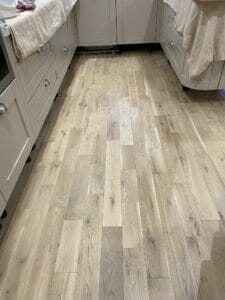
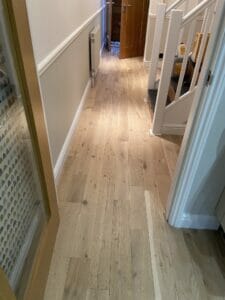
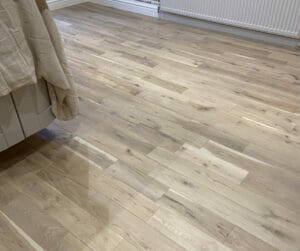
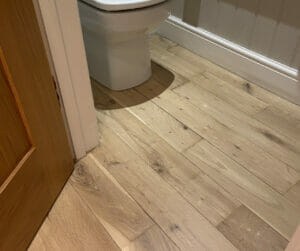
I’m sure you will agree that they are just as stunning as any other wood floor you can find! Wood floors bring an air of elegance and character to any room.
Here are some solid wood floors we have lovingly restored:
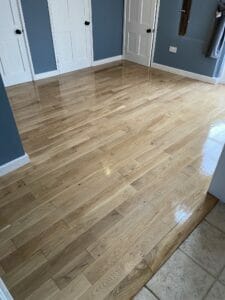
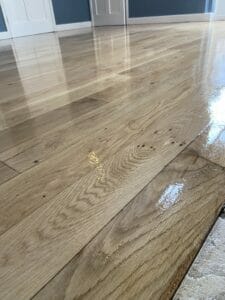
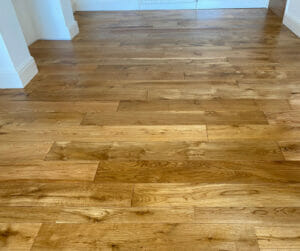

Aren’t they beautiful??!!
These are three ways you can look at yourself to see if you have an engineered or solid wood floor:
Look at the sides of your planks to tell if its an engineered or solid wood floor:
An easy way to tell solid hardwood apart from engineered wood is to look at the sides of a loose plank. If it is engineered hardwood, many layers of wood are stuck together.
It is solid hardwood if it is a solid piece of wood with a continual grain. You can only use this method if you have a loose plank… if the floor is installed and has no loose boards, you’ll need to use one of the other ways I’m about to tell you about.
Using Your fingertips to tell if its an engineered or solid wood floor:
Look for a space in the areas around baseboards, cabinets, and closets. These areas have cut boards fitted into tight spaces, which causes a small space between the floor and the wall. You can get a close look between the wall and the floor using a mirror.
Using your fingertip to tell if its an engineered or solid wood:
They generally finish engineered hardwood with an aluminium solution that they bake on… not like solid hardwood that they finish with polyurethane that can mark with a fingernail! Baked aluminium oxide typically can’t be dented. So… If you press your thumbnail into a hidden spot to tell if you have an engineered floor. However, this isn’t a foolproof way to test.
Other differences between engineered wood floors and solid wood floors:
There are five ways engineered floors are different from solid wood floors.
Durability:
Both types of hardwood offer similar toughness and durability. Solid woods still top the list as they are naturally sturdier and permanently glued or nailed to your subfloor. However, when it comes to withstanding different highs and lows of temperatures… solid woods have higher chances of buckling. Engineered wood also has better structural stability. Even though this is a benefit, the durability of engineered wood isn’t comparable to solid wood. This is because the surfaces on these engineered types are relatively thin… which makes them chip over time.
Cost:
Engineered hardwood is normally less expensive than solid hardwood. However, this usually depends on the species and wood quality you choose. There is no exact cost for any hardwood type… the price range varies considerably.
If you’re looking for a company that installs wood floors… our sister company, Art of Flooring, is fantastic at what they do. Rather than taking my word for it, check out their page by clicking here: Art of Flooring.
Moisture resistance:
Engineered wood floors have the upper hand when it comes to withstanding any moisture. Manufacturers make engineered wood from a plywood base, making them less prone to moisture… which causes the plank of wood less likely to warp or flex. The reason it’s less likely is that plywood is fibres that run in cross-way layers, so it builds their resistance to moisture.
Solid hardwood floors are unsuitable for areas prone to moisture… which means they shouldn’t install in places like the bathroom or areas that need regular mopping.
This doesn’t mean solid hardwood is entirely helpless against moisture… it can withstand moisture. However, this will depend on if the wood is site-finished or pre-finished. They usually top the site-finished wood with a sealant that helps to absorb moisture.
Environmental considerations:
If you would like to reduce your carbon footprint, engineered hardwood floors are more eco-friendly than any solid wood floor. Engineered hardwood is produced using a less wasteful process and requires less energy than most other types of flooring.
That doesn’t mean that solid hardwood isn’t an eco-friendly option… you can choose an environmentally friendly type of solid wood. Make sure you purchase it from a responsible supplier that’s certified.
Installation:
Different installation options are available for engineered wood floors as they are less likely to react to heat or buckle. This means the installation can be below or above ground level. However, solid wood contracts and expands over time, making them only suitable for above-ground-level installations.
Because there are different ways to install engineered wood floors, and they can install them in other spaces… This will be the best option if you intend to lay the floors yourself.
Most engineered wood can be either glued or nailed down. You can also choose a style where the planks lock together without fasteners.
Solid wood floors require a longer installation process and are laid with a flooring nailer before being sanded and finished. Sanding solid wood floors is a challenging job and would be best left for a professional if you want a neater and quicker job.
Check out this blog if you’re looking for a company that does wood floor restoration/sanding:
If you want to see some reviews, not just ours:
How to protect against your furbabies:
 Written by Tracey Gilbey, Marketing and Admin Coordinator at Art of Clean.
Written by Tracey Gilbey, Marketing and Admin Coordinator at Art of Clean.
For further advice or information on our Carpet and Soft Furnishing care, please do not hesitate to contact the Art of Clean team on 01223 901551 in Cambridge. Our services include Carpet Cleaning, Upholstery Cleaning, oriental and area Rug Cleaning, Curtain Cleaning, Patio, and Driveway Pressure washing, Leather Cleaning, Stone and Tile Floor Cleaning, and Wood Floor Sanding and Restoration. We also supply new flooring and carpets through our sister company Art of Flooring. Farthings Cambridge provides our Dry-Cleaning service

